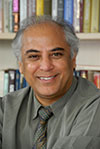Acclaimed physicist to join Fermilab and NIU
 |
|
Swapan Chattopadhyay
|
This fall Fermilab has the honor of welcoming internationally renowned physicist Swapan Chattopadhyay in a joint appointment with Northern Illinois University. Chattopadhyay's accomplishments span the realm of particle physics, but his forte lies in accelerator science and technology — a specialty from which both members of the appointment hope to benefit.
Currently serving as the director of UK's Cockcroft Institute, Chattopadhyay will join Fermilab's senior leadership team and will assist the accelerator research team labwide, working on a variety of advanced research projects. At NIU he will be a distinguished professor and serve as director of accelerator research.
Fermilab Director Nigel Lockyer noted that Chattopadhyay's expertise would help the laboratory align with the recently released P5 report.
"Swapan will be a crucial component to Fermilab's efforts to fulfill its part of the P5 vision for the future of particle physics," Lockyer said. "We are very excited to have him on our team."
Accelerator Division Head Sergei Nagaitsev agrees.
"As a joint NIU-Fermilab appointee, Swapan is an excellent addition to our accelerator research team," Nagaitsev said. "This is a unique opportunity for Fermilab to further its research goals and its presence in the accelerator and beam physics sciences."
In Chattopadhyay's decades of experience, he has fulfilled leadership roles in accelerator physics at University of California, Berkeley, at Lawrence Berkeley National Laboratory, where he founded and directed the Center for Beam Physics Berkeley, and Jefferson Lab, where he served as associate laboratory director for accelerators.
"With his help, we hope to establish a very strong enterprise that aligns with the Fermilab vision," said Vladimir Shiltsev, head of Fermilab's Accelerator Physics Center.
For the past seven years, Chattopadhyay served as the inaugural director of the UK-based Cockcroft Institute of Accelerator Science and Technology and as Sir John Cockcroft chair of physics at the universities of Liverpool, Manchester and Lancaster, where he sparked major advances in accelerator sciences, promoted critical collaborations with CERN and other global laboratories and, ultimately, helped establish the Cockcroft Institute as an internationally distinguished leader in accelerator physics.
"With its unique accelerator test facilities and a world-class skills base, Fermilab has the distinction of being the sole institution in the United States responsible for the nation's stewardship of the field of high-energy physics in the global context," Chattopadhyay said.
Scientists in the Accelerator Division and Accelerator Physics Center plan to work with Chattopadhyay to invent, implement and explore new, powerful and effective accelerator-based programs.
"It feels genuinely gratifying to be desired by the lab and I am honored to receive such warm welcome from my colleagues and leadership at Fermilab," Chattopadhyay said. "It is now time to dedicate myself to research that advances this great institution and serve the scientific community to secure the next high-energy physics facilities."
—Hanae Armitage
|